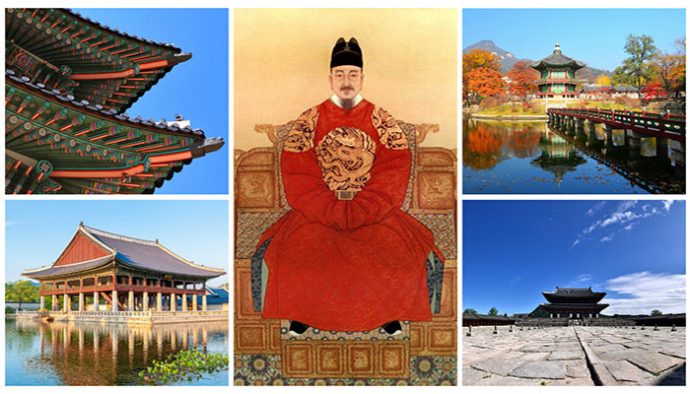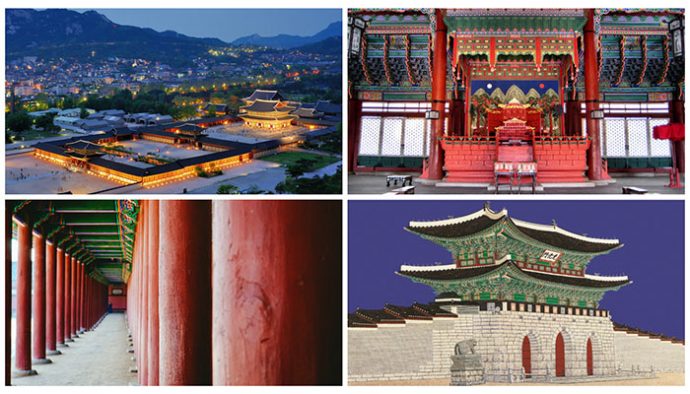Gyeongbokgung also known as Gyeongbok Palace was the main royal palace of the Joseon dynasty. Lee Seong-gye or the Taejo of Joseon initiated the construction of the “palace of happiness” when he decided to settle the capital in Seoul.
Gyeongbokgung is the largest of the Five Grand Palaces built during Joseon dynasty. Its walls enclosed no less than 500 buildings. Furthermore, it was the Kings’ households, as well as the government center. The King Taejong extended the palace during his reign. His son, King Sejong the great, extended it too. The latter created the Korean alphabet there, in Gyeongbokgung.

The architecture follow the influence of China to respect the “Feng Sui” concept. So, the area where the palace was set up was really important. This idea of circulation of energy was essential at that time, and they called it “Pungsu” in Korean.
The palace is facing the South to enjoy the sun longer, and the mountains behind protect it from the cold wind coming from the North. As it was the Royal family household, the architecture was spectacular. Gwanghwa Gate, Heungnye Gate or the throne room Geunjeongjeon are perfect examples. These huge structures represented the honor of the Nation.
Gyeongbokgung is a jewel of Korean history. Its stone walls, its rooftops with Haetae statue reflect the architectural elegance of Joseon dynasty. Gyeonghoeru Pavilion, where the banquet took place and Hyangwonjeong Pond are considered as the most beautiful example of Korean architecture style.
A symbol which have suffered
Gyeongbokgung is a place which have suffered trough centuries. First, a part of the palace burned in 1553. Even if damages were huge and the rehabilitation was expensive, King Myengjong ordered it.
It was burned once again, during the Japanese Invasion, the Imjin War, from 1592 until 1598. At that time Toyotomi Hideyoshi troupes walk in the capital city but the one who burned the palace were the slaves. They wanted to erase all traces of their past condition. For the next 273 years, the Royal Family established them in Changdeokgung not far from the former palace. Gyeongbokgung grounds were left derelict until being rebuilt in 1867 under the leadership of Regent Heungseon Daewongun.
The new one counted about 330 building and 5.792 rooms spread over more than 4 hectares. Within the palace walls were the Outer Court, offices for the king and state officials. While, the Inner Court, included living quarters for the royal family as well as gardens for leisure.
In 1895, after the assassination of Empress Myeongseong by Japanese agents, her husband, Emperor Gojong (1852-1919), left the palace, where the royal family never returned.
The Japanese demolished Gyeongbokgung during the occupation of the early 20th century. They wanted to destroy and erase the symbol of national sovereignty. In 1911, the Japanese Governor-General obtained the ownership of the land of the Palace. Furthermore, in 1915, on the pretext of holding an exhibition, more than 90% of the buildings were torn down. Following the exhibition, the Japanese wrecked whatever remained. Then, they built their colonial headquarters, the Government-General Building, on the site.
The newfound pride
Korean Government launched a reconstruction program in 1989 and will begin in 1990. The program lasted 40 years. They removed the Government-General Building in 1996. After that, Heungnye Gate and Gwanghwa Gate were reconstructed in their original locations and forms. They also complete the reconstructions of the Inner Court and Crown Prince’s residence.

Nowadays, Gyeongbokgung is one of the most famous place to see in Seoul city. It’s a must see if you come to visit Korea. It is located in the heart of the city and its popularity grew years by years. The Palace also houses the National Folk Museum that you can visit for free. The main palace is also famous because it showcases the Changing Guard Ceremony.
Royal Guard Ceremony : Go back to Joseon dynasty
After historical research, The changing Royal guard ceremony has been from 1966. It respects customs, with royal uniforms, weapons, and traditional instruments.
During Joseon dynasty, the Gates’ guards had a lot of responsibilities both at the fortress and at the Royal Palace. It was divided into two parts: The Seoul’s Guard and the Royal one. The latter played a significant role as they ensured the security of the Royal family. This Guard was in charge of open and close the Palace’s doors but also to watch day and night, patrol and control everybody.
Check out The Five Grand Palaces in Seoul

If you have the opportunity, I encourage you to go and see it. It is a scene full of colors and traditions so be sure to not missed it!
If this article give you the will to visit this fantastic place please feel free to check our best private day tour Old and New Seoul City Tour
or you can check out more tours if you want to visit this palace:
Half day Seoul city tour
Korean War History Tour
10D9N Highlights of Korea Group Tour
Gyeongbokgung Palace is one of the best things to see in Seoul, check out more best things to see and do in Seoul below:
